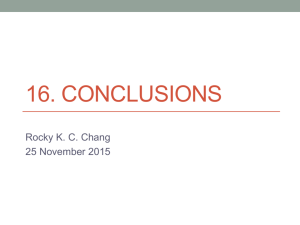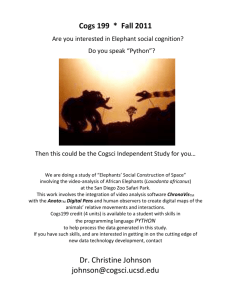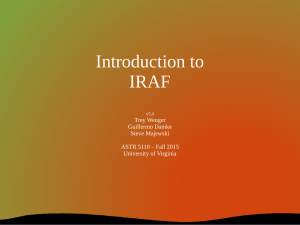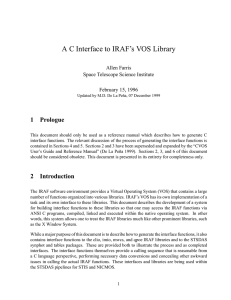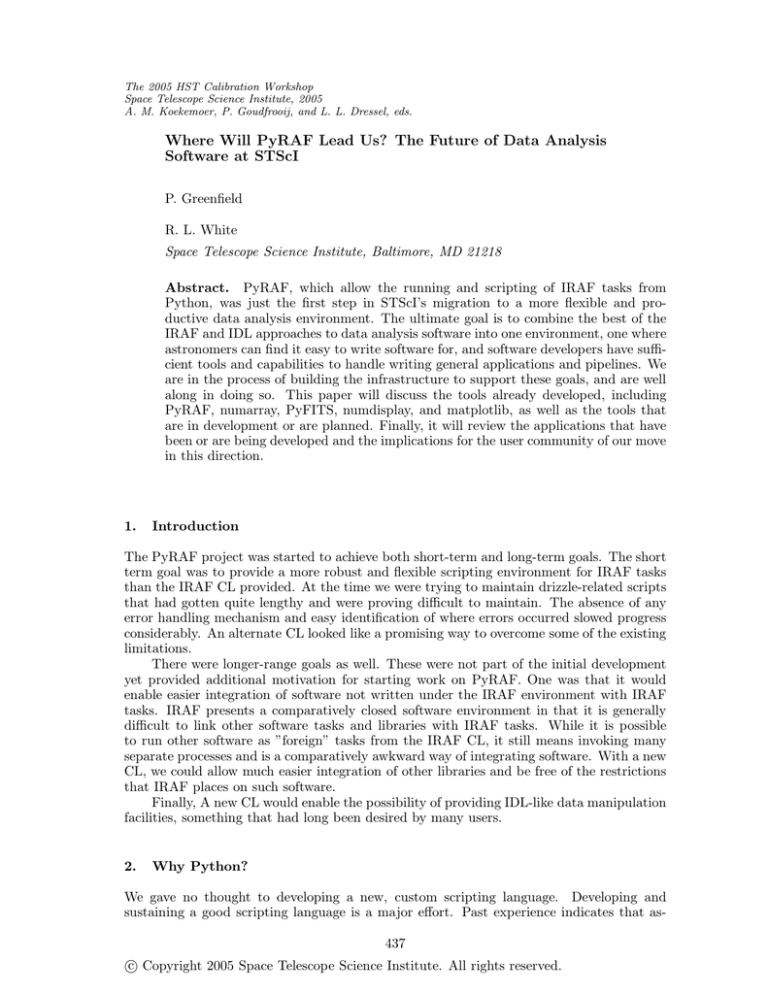
The 2005 HST Calibration Workshop
Space Telescope Science Institute, 2005
A. M. Koekemoer, P. Goudfrooij, and L. L. Dressel, eds.
Where Will PyRAF Lead Us? The Future of Data Analysis
Software at STScI
P. Greenfield
R. L. White
Space Telescope Science Institute, Baltimore, MD 21218
Abstract. PyRAF, which allow the running and scripting of IRAF tasks from
Python, was just the first step in STScI’s migration to a more flexible and productive data analysis environment. The ultimate goal is to combine the best of the
IRAF and IDL approaches to data analysis software into one environment, one where
astronomers can find it easy to write software for, and software developers have sufficient tools and capabilities to handle writing general applications and pipelines. We
are in the process of building the infrastructure to support these goals, and are well
along in doing so. This paper will discuss the tools already developed, including
PyRAF, numarray, PyFITS, numdisplay, and matplotlib, as well as the tools that
are in development or are planned. Finally, it will review the applications that have
been or are being developed and the implications for the user community of our move
in this direction.
1.
Introduction
The PyRAF project was started to achieve both short-term and long-term goals. The short
term goal was to provide a more robust and flexible scripting environment for IRAF tasks
than the IRAF CL provided. At the time we were trying to maintain drizzle-related scripts
that had gotten quite lengthy and were proving difficult to maintain. The absence of any
error handling mechanism and easy identification of where errors occurred slowed progress
considerably. An alternate CL looked like a promising way to overcome some of the existing
limitations.
There were longer-range goals as well. These were not part of the initial development
yet provided additional motivation for starting work on PyRAF. One was that it would
enable easier integration of software not written under the IRAF environment with IRAF
tasks. IRAF presents a comparatively closed software environment in that it is generally
difficult to link other software tasks and libraries with IRAF tasks. While it is possible
to run other software as ”foreign” tasks from the IRAF CL, it still means invoking many
separate processes and is a comparatively awkward way of integrating software. With a new
CL, we could allow much easier integration of other libraries and be free of the restrictions
that IRAF places on such software.
Finally, A new CL would enable the possibility of providing IDL-like data manipulation
facilities, something that had long been desired by many users.
2.
Why Python?
We gave no thought to developing a new, custom scripting language. Developing and
sustaining a good scripting language is a major effort. Past experience indicates that as437
c Copyright 2005 Space Telescope Science Institute. All rights reserved.
438
Greeenfield & White
tronomy is not a large enough field to warrant such an effort. Many scripting languages
already existed and had sizable development communities.
In effect, one such ’scripting’ language was already in wide use in astronomy, namely
IDL. Granted, it isn’t generally regarded as such, and although it isn’t as general purpose
as many of these, it shares at least a few characteristics with the better known ones to
be viewed as one. Given its wide prevalence in astronomy, it was an obvious choice for
trying as an alternate CL for IRAF. It’s use would automatically satisfy the second of our
long-term goals. Unfortunately, it lacked the necessary features to run IRAF tasks at the
level of control we desired. This was the primary reason for rejecting it, though there were
other important, but more secondary reasons. These included its cost, poor support for
easily distributed C or Fortran extensions, and that it was not as general-purpose as other
scripting languages, both in its language and library capabilities.
We deemed it important that any selected scripting language be popular enough, and
have a bright enough future that it would be expected to be around many more years. At
the time, there were three popular open source scripting languages: Perl, Tcl, and Python.
The first, while very powerful and the most popular, was (and still is) considered difficult
to learn, quirky, and led to code that was difficult to read, understand, and maintain. It
generally is difficult to write large, maintainable programs in Perl. Tcl, on the other hand,
has poor support for numerical types that rendered it unsuitable for astronomical contexts.
That left Python. It appeared to have all the necessary qualities including:
• Free, Open Source
• Very strong (deep and broad) user and development community
– Still growing
– Long lifetime expected
• General purpose
• Very portable
• Very extensible (in Python and with compiled code)
• Comparatively easy to learn
– Yet very powerful
• Scales well
It was the clear choice at the time, and continues to be (http://www.python.org).
Initially, our goals were modest. We were not seeking to support IRAF graphics nor
IRAF CL syntax. As the project progressed, we found that both these capabilities were
within reach without enormous effort.
3.
PyRAF Capabilities
Work on PyRAF began in 1998, and by mid-1999 it was being used internally at STScI. The
first public beta release occurred in spring 2000. PyRAF provided a number of capabilities
that were not present in IRAF at the time (a form of error handling and error traceback, as
well as more conventional command line recall, have recently been added to IRAF, and are
available in a beta release). The most notable aspect of PyRAF is that it doesn’t require
any changes to IRAF itself. It coexists with the existing IRAF CL; one can run one or the
other once PyRAF is installed. PyRAF provides enhancements for interactive users and
script writers.
For interactive users, the enhancements include:
PyRAF and the Future of Data Analysis Software
439
• IRAF CL syntax accepted (as well as Python syntax)
• Ability to run most CL scripts
• Simple, up-arrow command line recall
• Tab completion of file names and commands
• Resizable GUI Graphics windows with plot recall
• GUI epar editor
For scripting, the following is possible:
• Full Python exception handling1
• Traceback information on error location
• Capture of task standard output to Python list structure
Not all aspects of the IRAF CL are currently supported. None of the current omissions
are intrinsically not possible. Many are planned to be added in future enhancements (all
those marked with *). Some arise from the fact that the IRAF CL behavior is not well
documented, and arise from user reports on discrepancies in behavior. These are noted
and fixed as needed (more minor discrepancies remain and will be fixed in future releases).
Some discrepancies will never be corrected as they highlight IRAF features that are best
not emulated since they allow poor programming practices. Examples of these sorts of
features include the ability to minimum match declared procedure variables (one may use
x in place of xcoord if nothing else starts with x) or change variables outside of the scope
of the procedure. In those cases we strongly recommend that IRAF CL scripts that use
them be modified not to depend on such features (this is always possible and generally not
difficult to do). The following list gives the major differences that currently remain.
• GOTOs not supported (next release will support forward GOTOs; already implemented).
• Background tasks*
• Package unloading*
• Text-based epar (for remote terminal use)*
• Graphics redirection*
• Emulation of new IRAF CL error handling*
In addition to the currently marked differences between the IRAF CL and PyRAF,
we plan many enhancements for PyRAF in the next year. Although we are no longer
writing much software that requires PyRAF functionally (i.e., our new software no longer
is written within the IRAF environment), it is still very important for our user community
since it allows our new software to be run in an environment that is familiar to IRAF users
and provides a nearly identical user interface. It also will play a key role in the Gemini
calibration pipelines.
Further information may be found at:
http://www.stsci.edu/resources/software hardware/pyraf
1
Note that the new error handling capability provided in IRAF ECL beta release does not provide exception
handling in the usual sense. It executes the entire block of code and then jumps to the error handler at the
end regardless of where the error occurs. Most exception handlers jump immediately on the error.
440
4.
Greeenfield & White
Python’s Larger Role
It is becoming well recognized by many software developers in astronomy (if not yet astronomers) that Python is a very good choice as a scripting language. Indeed, many of the
existing or new astronomical software now sport, or will soon, some sort of Python interface.
For example:
• Midas: PyMidas
• AIPS: Parseltongue
• ALMA
• CIAO/s-lang: PySL
The availability of Python interfaces to these systems will make it far easier to write
scripts that combine capabilities from different systems.
Nevertheless, it is still a common viewpoint that Python is primarily only a scripting
language and that it doesn’t have a larger role to play in writing astronomical data analysis
and reduction software. We have a more ambitious view. Our success in developing PyRAF
led us to believe that it was a powerful language with the potential for being a primary,
rather than secondary, language to develop applications in, provided the necessary tools
were developed.
This was inspired, in part, by our previous experience with IDL that convinced us that
it was possible to use an interpreted language to develop many useful applications. The
presence of array manipulation facilities allows many computationally-intensive algorithms
to be efficiently implemented in the interpreted language. While it is admittedly true that
there are many scientific computation problems that are not well suited for array manipulations (e.g., fluid dynamics computations), our experience (and evidently the experience of
many astronomers as well, given IDL’s popularity in astronomy) was that such an approach
was well suited to many data analysis and reduction problems.
No single language is suitable for all problems. Python is no exception. Yet, it is more
sensible in our view to develop as much as possible in Python because of its highly productive nature than to take the more conventional approach of doing most development in a
compiled language such as Fortran (any variant), C, C++, or Java, and then use a scripting
language. The differences in productivity between the two approaches are startling, both in
lines of code required and development time. Typically one sees increases in productivity
ranging from factors 5 to 10 when switching from one of the traditional compiled languages
to Python (much the same improvements have been seen by IDL users as well). Since
Python provides very good interfaces to C (and thus to Fortran and C++), any part of
the code that is too slow can instead call compiled code. Even with heavily computational
code, generally speaking, most of the time spent in a program is usually confined to 10-20%
of the code. Even if that code cannot be efficiently written in Python, it can be rewritten
in C or Fortran. In other words: minimize the use of the less productive language.
An important side benefit of this approach is that it makes the code developed by
professional software developers much more accessible to astronomers, and makes it easier
for astronomers to contribute algorithms and utilities to a common software base. Currently,
the two communities have little overlap in the software they develop; ending this divide will
have many benefits.
5.
Enabling Python as a Data Reduction Language
Were the necessary facilities already available in Python? In part. There was an array
package, Numeric (aka numpy) already available. However, it had a number of features
PyRAF and the Future of Data Analysis Software
441
and characteristics that made it less desirable for dealing with the large data sets we see
in astronomy. It did not have the facilities for making efficient use of memory, nor could it
support an efficient use of table data structures. We also desired to use memory mapping
to minimize memory usage. For these and other reasons we decided on developing a new
array package, numarray (http://www.stsci.edu/resources/software hardware/numarray).
Another essential library needed to support the use of Python for applications was
a FITS module. This was initially developed by Paul Barrett and then adapted to use
numarray and provide table access. Despite being written in pure Python, it is significantly
faster for reading large files than the standard CFITSIO library, particularly for very large
files. (http://www.stsci.edu/resources/software hardware/pyfits)
Before Python could be considered a serious interactive environment for data analysis,
it had to have a capable way of visualizing data. We developed numdisplay to display images
to DS9 and ximtool. But for a long time, one of the biggest holes was the absence of a good
plotting package that met all our needs (which included being free, open source, portable
to all popular platforms, GUI-toolkit independent, image capable, and having high quality
hardcopy). This was finally filled with the adoption of the plotting package matplotlib developed by John Hunter at the University of Chicago (http://matplotlib.sourceforge.net/).
Besides extending the capabilities of these existing tools, efforts are beginning on addressing more astronomically-specific libraries that contain utilities similar to those found
in the IDL astron library to handle coordinate transformations, WCS coordinate systems,
and photometry. Most of this work is taking place on a public repository to encourage
contributions and enhancements from the general community.
(http://www.scipy.org/wikis/topical software/AstroLib)
Finally, there is currently an effort underway to unify the best aspects of the Numeric
and numarray array packages into one called scipy core (which will be as easy to install as as
Numeric or numarray). We have done initial testing of scipy core and it appears to satisfy
all of the functional requirements we have. The effort to port our libraries and applications
has begun. While scipy core does not have an identical interface to numarray, it is much
closer to numarray than Numeric in that regard. We will endeavor to make our software
coexist with both during some reasonable transition period.
6.
STScI Python Applications and Documentation
Most of STScI data analysis and reduction applications development is currently being done
in Python. The following list summarizes those that have already been distributed or are
completed and soon will be distributed. Most of these do not require IRAF at all (but
many can be run as IRAF tasks in PyRAF using the standard IRAF CL syntax and epar
interface). Most can be run on Microsoft Windows (though PyRAF cannot be because of
its current dependence on IRAF).
• PyDrizzle/Multidrizzle: Drizzles a set of HST images onto a common image. Multidrizzle can remove cosmic rays even without any common pointings.
(http://stsdas.stsci.edu/multidrizzle/)
• CALCOS: The calibration pipeline for the Cosmic Origins Spectrograph instrument
for HST.
• FITSDIFF: A utility for comparing FITS files for differences in the data or headers.
(Distributed with PyFITS)
• Various STIS tools (Distributed with stsci python/STSDAS):
– stisnoise: removes fixed pattern noise
442
Greeenfield & White
– sshift: aligns dithered spectral images
• PySPV: Python interface to Specview (Java GUI application)
• NICMOS saaclean tool: removes effects of SAA persistence
(distrbuted with stsci python/STSDAS)
• TFIT (from GOODS project): Does photometry on low resolution images using high
resolution images for prior information.
• WCS matching tool: A GUI application for deriving WCS information for press release
images from science images.
We have also developed a tutorial for astronomers showing how to use Python for
interactive data analysis: http://www.scipy.org/wikis/topical software/Tutorial
7.
The Future of Python at STScI
The more we use Python the more convinced we are that we made the right decision in
1998 to base our work on it. With the maturation of the tools for implementing data
analysis algorithms directly in Python we anticipate a substantial increase in the number
of astronomer-written scripts that are shared in the community. The STScI data analysis
software group is committed to continuing support and development of our Python tools
and applications, and we plan to help coordinate the distribution of user scripts and libraries
as well.
Acknowledgments. The various projects described here have involved many contributions by several people:
• PyRAF: Richard L. White, Perry Greenfield, Michele De La Pena, Warren Hack,
Philip Hodge
• numarray: Jay Todd Miller, Perry Greenfield, Jin Chung Hsu
• PyFITS: Paul Barrett, Jin Chung Hsu
• numdisplay: Warren Hack
• matplotlib: created and maintained by John Hunter at the University of Chicago
with STScI contributions from Nadia Dencheva, Paul Barrett, Jay Todd Miller, Perry
Greenfield
• Regression Test Framework: Howard Bushouse, Bernie Simon, Hemant Shukla
• PyDrizzle/Multidrizzle: Warren Hack, Christopher Hanley, David Grumm, Robert
Jedrzejewski
• CALCOS: Philip Hodge
• FITSDIFF: Jin Chung Hsu
• STIS tools: Paul Barrett
• NICMOS SAAClean: Victoria Laidler
• PySPV: Ivo Busko
• TFIT: Victoria Laidler
• Public Release WCS tool: Philip Hodge





